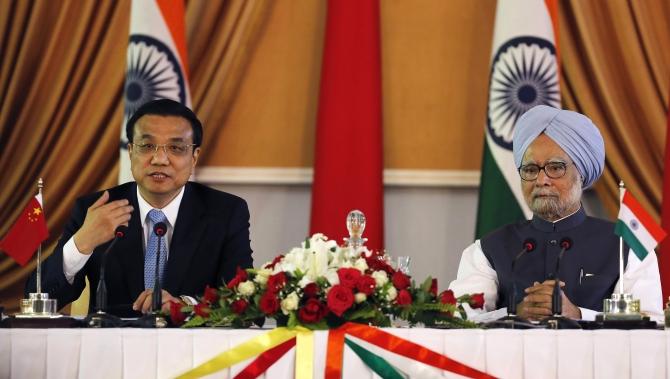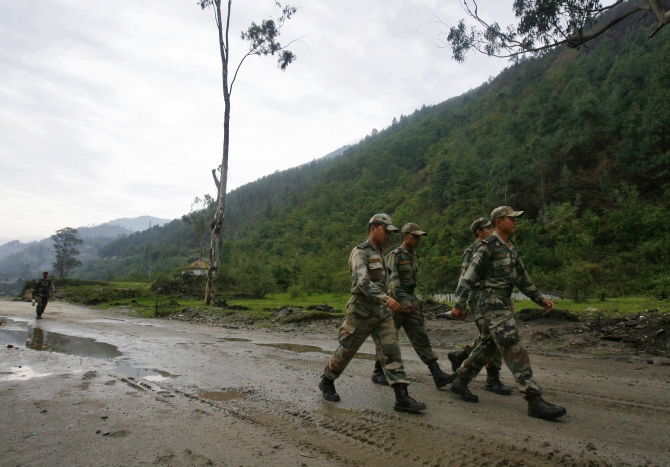Photographs: Adnan Abidi/Reuters
'Border disputes cannot be solved by resorting to border conflicts. Only by mutual consensus, and a spirit of give-and-take, can we arrive at a long-lasting solution,' says Professor Wang Dehua, ahead of Prime Minister Manmohan Singh's visit to China next week.
Professor Wang, bottom, left, a former director, Centre for South Asia Studies at the Shanghai Academy of Social Sciences, is currently a member of the China-India Co-operation Forum, jointly sponsored by the consulate general of India in Shanghai and the Tata Group at the China-Europe International Business School in Shanghai.
He has visited India many times in the last four decades and is known for his emphasis on balanced trade relations for a peaceful future for India and China.
On the eve of Dr Singh's visit to Beijing on October 22-23, Professor Wang wrote this piece exclusively for Rediff.com.
While bilateral relations between many rising powers have been conflictual, China and India stand as exceptions. Not only have the two countries managed their relations with each other and ensured peace on the unresolved border, they have also gone far in engaging each other in a mutually beneficial manner.
Indian Prime Minister Dr Manmohan Singh will be greeted by Premier Li Keqiang -- the two leaders enjoy great mutual respect -- as well as by the expectations of the Chinese government, public and the media.
 The question then arises: How do we perceive each other? How can we seize the opportunities to materialise new conceptions, as in the eyes of Chinese academics and policy leaders India is not a threat but an opportunity. Likewise, Indian leaders also publicly view China as an opportunity.
The question then arises: How do we perceive each other? How can we seize the opportunities to materialise new conceptions, as in the eyes of Chinese academics and policy leaders India is not a threat but an opportunity. Likewise, Indian leaders also publicly view China as an opportunity.
We hope Dr Singh's forthcoming China visit will upgrade the strategic partnership through confidence-building measures. I also find it useful to sum up the new elements of Sino-Indian relations in four expectations: Comprehensive strategic partnership through confidence building; Co-effects for an early solution of the boundary question; cooperation to boost trade and investment; Chindia for common prosperity.
Please read: 'India, China want pragmatism, no more bhai-bhai diplomacy'
Please ...
Four elements that will shape India-China ties
Image: Indian soldiers on the Tezpur-Tawang highway, which runs close to the Chinese border, in Arunachal Pradesh.Photographs: Frank Jack Daniel/Reuters
Comprehensive strategic partnership through confidence building measures (CBMs): This is the first and most important element of a new era in the relations between the two Asian giants poised to become world powers.
During Prime Minister Manmohan Singh's visit to China in January 2008, the two countries issued a joint document on a Shared Vision for the 21st Century, pledging to promote a harmonious world of peace and stability and further strengthening the Sino-Indian Strategic and Cooperative Partnership for Peace and Prosperity.
These developments have encouraged analysts across the Himalayas to talk about the return of the 1950s Panchsheel and the prospects of 'Chindia' in the coming decades.
Tremendous mutual misunderstanding and distrust have been propagated by news reports of border 'incursions' by Chinese troops; ever-present expert analyses on China's 'pearl necklace' strategy to isolate India by forming strategic alliances with Pakistan, Bangladesh and Sri Lanka; and by counter-analyses of India's alliances with Japan, South Korea, Australia and the US, in order to isolate China. These reports are meaningless and unhelpful.
War or military encirclement cannot resolve these issues or dismiss suspicions. It is interesting to note that lack of trust is also a defining aspect of China-US relations. With respect to India, there are certainly areas of high sensitivity such as China's close relations with Pakistan.
Please ...
Four elements that will shape India-China ties
Image: Chinese Premier Li Keqiang with Defence Minister A K Antony, left, at the Zhongnanhai Leadership Compound in Beijing, July 5, 2013.Photographs: China Daily/Reuters
Co-effects for early solution of the boundary question: We highly hope that Prime Minister Manmohan Singh's China visit will make a new push to settle a long-running border row, pledging his commitment to 'peace and tranquility.'
One message has consistently emerged from the period of intense engagement over the past decades including, most recently, the 16th round of talks on the border issue: There really is no need for China and India to adopt a mutually confrontational pose.
China and India have both suffered the terrible toll of colonial rule. India and China have held several rounds of border talks and are now on the fast track to solving these issues.
At this stage it is important to understand that border disputes cannot be solved by resorting to border conflicts.
Only by mutual consensus, and a spirit of give-and-take, can we arrive at a long-lasting solution.
Before the solution of the boundary question, it is urgent to reach an agreement of framework to maintain peace and tranquility in the border region.
India and China have decided to take further measures for maintaining peace and tranquility along their border following the recent standoff in Ladakh.
On May 29, 2006, the defence ministries of China and India signed the Memorandum of Understanding for Exchanges and Cooperation in the Field of Defence, which provides a sound foundation and institutional framework for further development of defence cooperation.
Please ...
Four elements that will shape India-China ties
Image: The conference room where Indian and Chinese military commanders meet, on the Indian side of the India-China border, at Bumla, Arunachal Pradesh.Photographs: Adnan Abidi/Reuters
Cooperation to boost trade and investment: Eventually this will form the backbone of Sino-Indian ties and will emerge as an important influencer of our future relations.
$70 billion is the oft-quoted figure with respect to India-China mutual trade. With no trouble at all, this figure can touch $100 billion within the next two years.
Bilateral trade reached $73 billion in 2011 when China became India's largest trade partner, but fell to $66 billion last year on account of the global downturn.
As of April this year, trade was down 6.2 per cent. Mr Jiang Yaoping, the Chinese vice commerce minister, however, said he was optimistic that the $100 billion target for 2015 would be 'realised on schedule'.
In a piece of good news for boosting Sino-Indian trade and investment, Shanghai officials recently announced plans to set up a pilot free trade zone that would meet international norms in the Pudong New Area, the city's financial and commercial hub, in 2013.
India has decided to establish a China industrial park in Uttar Pradesh, which are steps to 'facilitate Indian and Chinese companies's efforts to explore the counterpart market'.
Please ...
Four elements that will shape India-China ties
Image: A paramilitary trooper on the banks of the Brahmaputra on the outskirts of Guwahati.Photographs: Utpal Baruah/Reuters
Chindia for common prosperity: At the beginning of the 21st century, India and China have the unique opportunity and resources to improve mutual relations as well as to promote peace in their neighbourhood and the world.
Every Chinese leader, right from Chairman Mao to President Xi Jinping, has acknowledged India to be a great civilisation and a great power, and a complementary economic force parallel to China's own growth.
China has much to learn and benefit from Indian culture and philosophy: The Indian entrepreneurial spirit, the tradition of public debate and argument, and the fondness for logic and mathematical thinking are but a few of the attractive qualities that India has to offer. For lasting peace, both cultures and economies must continue to grow and prosper.
There are several aspects of our mutual relations that are clouded in doubt and false rhetoric and I will specifically address two.
The first is the issue of transparency regarding water security. The Indian side specifically doubts China's intentions on the Brahmaputra dam.
China must continue to clarify to India that in reality it has no intention of containing or controlling access for the lower riparian states.
Rather, China's stated -- and bona fide -- intention has been flood control.
The second aspect that urgently needs transparency is India's game-plan on strategic sea-routes.
Contrary to speculation in Indian and Western academic/policy circles, China has no official game-plan to restrict or cut off India's access to sea-routes, including and especially in the Indian Ocean area.
China has no hegemonic ambitions on that count; however, this needs to be made transparent and mutually intelligible to policy communities in both countries.
I would go so far as to suggest that we reach back in our history in order to revive the spirit of Zheng He, the great Chinese naval explorer who charted sea routes through Malacca and onto Africa and India.
What we need is a symbolic revitalisation of the Silk Route -- through land and sea.
A harmonious Indian Ocean characterised by peaceful cooperation between the Great Powers is in everyone's best interests.
...






article